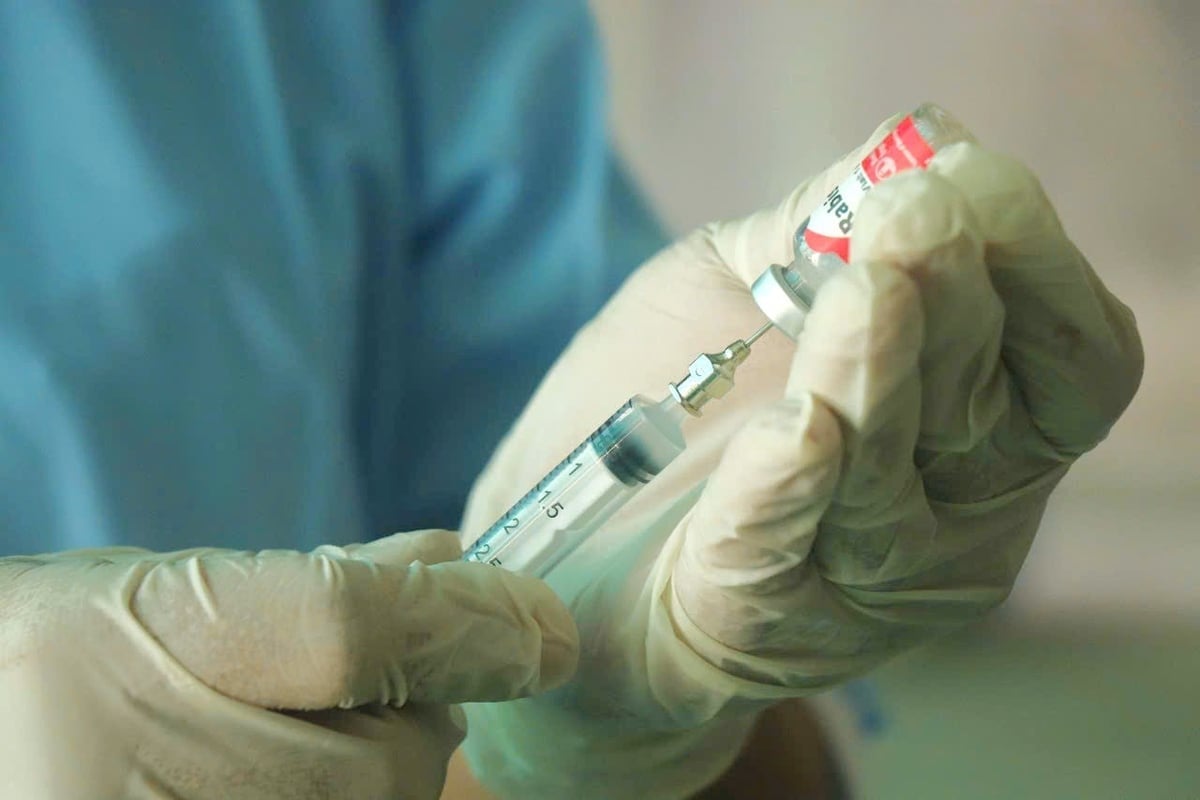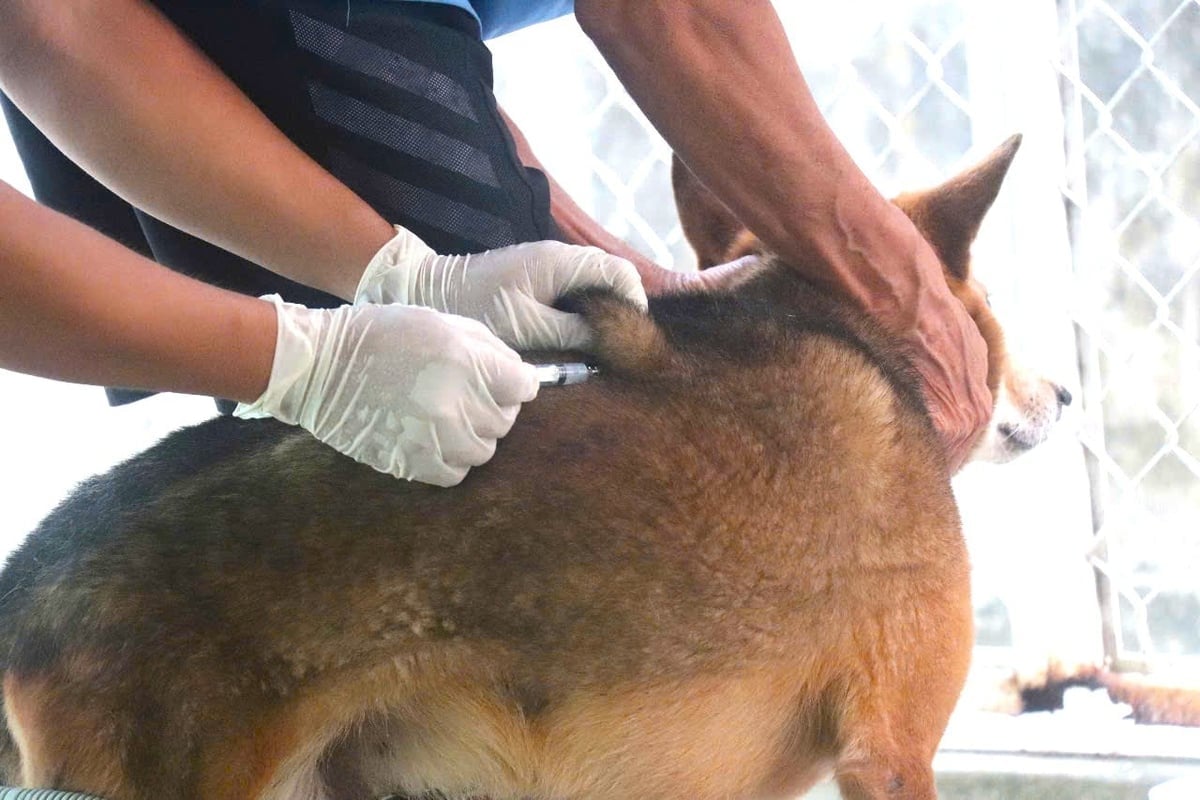December 4, 2025 | 17:24 GMT +7
December 4, 2025 | 17:24 GMT +7
Hotline: 0913.378.918
December 4, 2025 | 17:24 GMT +7
Hotline: 0913.378.918
Can Tho City Department of Agriculture and Environment has just launched a campaign to vaccinate livestock against dangerous infectious diseases in 2025, creating active immunity for livestock and thus contributing to the effective prevention of dangerous epidemics.
According to the 2025 plan, the livestock and veterinary sector of Can Tho City aims to achieve a rate of over 80% of the livestock subject to vaccination. As for dogs and cats, rabies vaccination must also ensure at least 80% of the total herd in each locality.

Can Tho city strives to reach a vaccination rate of over 80% of the total number of livestock subject to vaccination by 2025. Photo: Kim Anh.
The 2025 vaccination campaign will be divided into two phases. Phase 1 will be from April 25 to June 15, 2025, and phase 2 will take place from August to November 2025. The Department of Agriculture and Environment of Can Tho city also calls for the Sub-Department of Livestock Production and Animal Health to coordinate with local authorities. The goal is to organize additional vaccinations for newly raised livestock, herds that have not been fully vaccinated, have expired their immunity period, or at the request of livestock farmers.
Nguyen Tan Nhon, Deputy Director of Can Tho City Department of Agriculture and Environment, emphasizes the importance of regular vaccination as one of the most effective, sustainable and economical disease prevention measures. The cost of vaccination is not high, but it brings great benefits in protecting the health of livestock, minimizing economic risks and protecting the health of farmers.
To achieve high efficiency, Deputy Director Nhon suggests that district and commune authorities direct communes and wards to increase communication and mobilize people to actively participate in vaccinating livestock.
It is necessary to implement bio-safe farming to prevent the spread of disease in the herd and from animals to humans. Vaccination of dogs and cats is particularly important to prevent rabies, a constant threat to the community.

Vaccination of livestock is one of the safe and effective measures to prevent epidemics. Photo: Kim Anh.
"After communication and mobilization, if people still do not comply with livestock vaccination, the specialized sector needs to apply administrative measures to create deterrence and force people to seriously follow regulations," says the Deputy Director of Can Tho City Department of Agriculture and Environment.
In Truong Lac ward, O Mon district, Luu Minh Bao is raising more than 50 pigs. In addition to strictly following the vaccination schedule for the pigs, his family also maintains hygiene in the barn and limits the entry of strangers. Thanks to fully implementing these measures, his pigs have not been affected by dangerous diseases such as foot and mouth disease or blue ear disease for many years.
With the complicated development of the epidemic, Bao is still concerned about the risk of an outbreak of African swine fever. Can Tho City has not yet implemented vaccination for this disease at present, so farmers hope to have vaccines soon to feel secure during production.

Rabies in dogs and cats has a very high risk of being transmitted to humans without full vaccination. Photo: Kim Anh.
In recent years, the livestock production and animal sector of Can Tho city has made many developments, contributing positively to food security and improving people's income. However, the vaccination rate for livestock has not yet reached the expected level.
The vaccination rate for lumpy skin disease in cattle in 2024 reached just over 70%; foot and mouth disease in cattle reached over 85% and 75% in pigs. Vaccination for blue ear disease reached 84%. Rabies in dogs and cats in particular reached nearly 90%.
One thing to note is that in rural and suburban areas, due to free-range farming practices, disease control and vaccination are difficult. This makes the risk of dangerous disease outbreaks always high, especially rabies, which can be transmitted to humans.
The launching ceremony for the implementation of vaccination against dangerous infectious diseases in livestock in 2025 in Can Tho City was held on April 26 to strengthen information dissemination, communication and promote the good implementation of vaccination as this would help create protective immunity to prevent dangerous infectious diseases that arise and spread in livestock, maintain a regular level of antibodies in the livestock population to prevent disease.
The vaccination campaign was also considered a way to strengthen the leadership role of local authorities, departments, branches and the responsibility of the people to develop stably, avoid the risk of epidemics causing economic losses, and also prevent diseases transmitted from animals to humans that threaten human life.
Translated by Samuel Pham

(VAN) After three years, Project FST/2020/123 collected approximately 3,000 insect specimens, classified them into about 50 morphological groups, and identified around 40 species, including several new species.
/2025/12/01/0509-2-175427_206.jpg)
(VAN) Emission-reducing coffee areas in Lam Dong have entered the new crop with stable yields, improved quality, and a remarkably enhanced cultivation environment.

(VAN) The Institute of Agricultural Sciences for Southern Vietnam (IAS) marked its 100th anniversary in Ho Chi Minh City, celebrating a century of growth as a leading institute contributing significantly to Viet Nam’s agricultural development.

(VAN) An increasing number of livestock farms are using biogas generators to create a source of renewable electricity, helping to save costs and mitigate environmental pollution.

(VAN) Small changes in rice cultivation, from irrigation methods and straw collection to input management, are paving a new way for Vietnam's agriculture in the journey toward emission reduction.

(VAN) With the project of converting biogas into renewable electricity, Australia is both helping pig farms reduce their energy costs by up to 25% and contributing to environmental protection.
![Hue aims for Net Zero: [1] Initial steps from green transportation](https://t.ex-cdn.com/nongnghiepmoitruong.vn/608w/files/huytd/2025/11/28/0853-anh-6-giao-thong-xanh-hue-094717_940-153724.jpg)
(VAN) For sustainable development, Hue City is implementing many solutions to promote green transportation, which is an important initial step on the journey to building a Net Zero Hue.